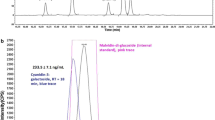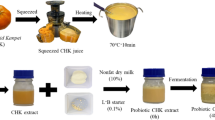Abstract
Indian gooseberry, Amla, is a highly nutritious fruit and one of the richest sources of vitamin C. However, due to its high acidity and astringent taste, it is not suitable for direct consumption. In this study, a blend of amla, guava, and ginger was evaluated as a fermentable substrate by lactic acid bacterial (LAB) fermentation, to improve the quality and stability of this low-pH fruit and to develop a fermented non-dairy beverage. The study results showed that the amla blend was an excellent matrix for LAB growth, with more than 9.38 log10 CFU/mL of viable counts at the end of fermentation. LAB fermentation dramatically increased the total phenolic content, flavonoid content, and antioxidant capacities based on DPPH and FRAP methods. The stability of the fermented amla beverage (FAB) was investigated after storage at 4 °C for 90 days, and there was a healthy bacterial population of 7.43 log10 CFU/mL. The FAB also showed potential as a bio-intervention with enhanced antioxidants, polyphenols, and flavonoids with anti-proliferative activity. Inhibition of the growth of Caco-2 and MOLT 4 cancerous cell lines was observed in a dosage and time-reliant manner, respectively, with considerably high inhibition at 10,000 μg/mL and at 120 min, respectively. This way, lactic acid fermentation can be considered an appropriate tool for developing an amla-based novel bio-intervention with enhanced antioxidants, polyphenols, and flavonoids with anti-proliferative activity and antagonistic efficacy against recurring foodborne pathogens in this post-antibiotic era.




Similar content being viewed by others
Data availability
The data that support the findings of this study are not openly available and are available from the corresponding author upon reasonable request.
Code availability
Not applicable.
Abbreviations
- LAB:
-
Lactic acid bacteria
- FAB:
-
Fermented amla beverage
- NFAB:
-
Non-fermented amla beverage
- TPC:
-
Total phenolic content
- TFC:
-
Total flavonoid content
- %SA:
-
%Scavenging activity
- FRAP:
-
Ferric Reduction Antioxidant Power
- MOLT-4 cell line:
-
Human T-lymphoblast; acute lymphoblastic leukemia
- CaCo2:
-
Colorectal carcinoma cells
References
L. Vandenberghe et al., The potential of probiotics: a review. Food Technol. Biotechnol. 48(4), 413–434 (2010)
K.Y. Yoon, E.E. Woodams, Y.D. Hang, Production of probiotic cabbage juice by lactic acid bacteria. Bioresour. Technol. 97(12), 1427–1430 (2006)
R. Modi, I. Kaur, P. Sahota, Lactic acid bacteria as an adjunct starter culture in the development of metabiotic functional black pearl grapes beverage. Environ. Conserv. J. 23(3), 71–80 (2022)
J. Szutowska, Functional properties of lactic acid bacteria in fermented fruit and vegetable juices: a systematic literature review. Eur. Food Res. Technol. 246(3), 357–372 (2020)
P. Filannino et al., Exploitation of the health-promoting and sensory properties of organic pomegranate (Punica granatum L.) juice through lactic acid fermentation. Int. J. Food Microbiol. 163(2–3), 184–92 (2013)
M.S. Baliga, J.J. Dsouza, Amla (Emblica officinalis Gaertn), a wonder berry in the treatment and prevention of cancer. Eur. J. Cancer Prev. 20(3), 225–239 (2011)
B.C. Variya, A.K. Bakrania, S.S. Patel, Emblica officinalis (Amla): a review for its phytochemistry, ethnomedicinal uses and medicinal potentials with respect to molecular mechanisms. Pharmacol. Res. 111, 180–200 (2016)
S. Rezac et al., Fermented foods as a dietary source of live organisms. Front. Microbiol. 9, 1785 (2018)
G. Pandove, P. Sahota, N. Gupta, Development of low alcoholic naturally carbonated fermented debittered beverage from grapefruit (Citrus paradisi). J. Appl. Nat. Sci. 8, 1649–1653 (2016)
P. Sahota et al., Evaluation of a BWTK for detection of total coliforms, E. coli and emerging pathogens from drinking water: comparison with standard MPN method. Water Sci. Technol. 62(3), 676–83 (2010)
E. Kim, S.M. Yang, H.Y. Kim, Analysis of cultivable microbial community during Kimchi fermentation using MALDI-TOF MS. Foods 10(5), 1068 (2021)
M.H. Zwietering et al., Modeling of the bacterial growth curve. Appl. Environ. Microbiol. 56(6), 1875–1881 (1990)
C. Aydın, R. Mammadov, Phenolic composition, antioxidant, antibacterial, larvacidal against Culex pipiens, and cytotoxic activities of Hyacinthella lineata steudel extracts. Int. J. Food Prop. 20(10), 2276–2285 (2017)
E. Kwaw et al., Effect of fermentation parameters and their optimization on the phytochemical properties of lactic-acid-fermented mulberry juice. J. Food Meas. Charact. 11(3), 1462–1473 (2017)
B. Suárez et al., Phenolic profiles, antioxidant activity and in vitro antiviral properties of apple pomace. Food Chem. 120(1), 339–342 (2010)
M. Fazaeli, G. Hojjatpanah, Z. Emam-Djomeh, Effects of heating method and conditions on the evaporation rate and quality attributes of black mulberry (Morus nigra) juice concentrate. J. Food Sci. Technol. 50(1), 35–43 (2013)
E. Kwaw et al., Effect of lactobacillus strains on phenolic profile, color attributes and antioxidant activities of lactic-acid-fermented mulberry juice. Food Chem. 250, 148–154 (2018)
S. Er, A. Koparal, M. Kivanc, Cytotoxic effects of various lactic acid bacteria on Caco-2 cells. Turk. J. Biol. 39, 23–30 (2015)
M.G.M. Costa et al., Sonicated pineapple juice as substrate for L. casei cultivation for probiotic beverage development: process optimisation and product stability. Food Chem. 139(1), 261–266 (2013)
I. Ferrari Pereira Lima et al., Development of an innovative nutraceutical fermented beverage from herbal mate (Ilex paraguariensis A. St.-Hil.) extract. Int. J. Mol. Sci. 13(1), 788–800 (2012)
M. Kieliszek et al., Characteristics of the proteolytic enzymes produced by lactic acid bacteria. Molecules 26(7), 1858 (2021)
S.J. Hur et al., Effect of fermentation on the antioxidant activity in plant-based foods. Food Chem. 160, 346–356 (2014)
C.A. Torres, L.A. Romero, R.I. Diaz, Quality and sensory attributes of apple and quince leathers made without preservatives and with enhanced antioxidant activity. LWT Food Sci. Technol. 62(2), 996–1003 (2015)
C.-C. Ng et al., Lactic acid bacterial fermentation on the production of functional antioxidant herbal Anoectochilus formosanus Hayata. J. Biosci. Bioeng. 111(3), 289–293 (2011)
S.-C. Chu, C. Chen, Effects of origins and fermentation time on the antioxidant activities of kombucha. Food Chem. 98(3), 502–507 (2006)
K. Katina et al., Bran fermentation as a means to enhance technological properties and bioactivity of rye. Food Microbiol. 24(2), 175–186 (2007)
E.S. Lago-Vanzela et al., Aging of red wines made from hybrid grape cv. BRS Violeta: effects of accelerated aging conditions on phenolic composition, color and antioxidant activity. Food Res. Int. 56, 182–189 (2014)
Z.E. Mousavi et al., Effect of fermentation of pomegranate juice by Lactobacillus plantarum and Lactobacillus acidophilus on the antioxidant activity and metabolism of sugars, organic acids and phenolic compounds. Food Biotechnol. 27(1), 1–13 (2013)
G. Pereira-Caro et al., Chronic administration of a microencapsulated probiotic enhances the bioavailability of orange juice flavanones in humans. Free Radic. Biol. Med. 84, 206–214 (2015)
A. Chlebowska-Smigiel et al., The effect of pullulan on the growth and acidifying activity of selected stool microflora of human. Curr. Pharm. Biotechnol. 18(2), 121–126 (2017)
L. Wang et al., Dynamic changes in phenolic compounds, colour and antioxidant activity of mulberry wine during alcoholic fermentation. J. Funct. Foods 18, 254–265 (2015)
A. Waśko, M. Kieliszek, Z. Targoński, Purification and characterization of a proteinase from the probiotic Lactobacillus rhamnosus OXY. Prep. Biochem. Biotechnol. 42(5), 476–488 (2012)
F.O. Adetuyi, T.A. Ibrahim, Effect of fermentation time on the phenolic, flavonoid and vitamin C contents and antioxidant activities of okra (Abelmoschus esculentus) seeds. Niger. Food J. 32(2), 128–137 (2014)
F.A. Silva et al., Phenolic acids and derivatives: studies on the relationship among structure, radical scavenging activity, and physicochemical parameters. J. Agric. Food Chem. 48(6), 2122–2126 (2000)
A.R. Choi et al., Antagonistic activities and probiotic potential of lactic acid bacteria derived from a plant-based fermented food. Front. Microbiol. 9, 1963 (2018)
S.S. Choi et al., Effects of Lactobacillus strains on cancer cell proliferation and oxidative stress in vitro. Lett. Appl. Microbiol. 42(5), 452–458 (2006)
R. Kazimierczak et al., Beetroot (Beta vulgaris L.) and naturally fermented beetroot juices from organic and conventional production: metabolomics, antioxidant levels and anticancer activity. J. Sci. Food Agric. 94(13), 2618–29 (2014)
S.S. Tasdemir, N. Sanlier, An insight into the anticancer effects of fermented foods: a review. J. Funct. Foods 75, 104281 (2020)
S. Franceschi, C.P. Wild, Meeting the global demands of epidemiologic transition—the indispensable role of cancer prevention. Mol. Oncol. 7(1), 1–13 (2013)
Acknowledgements
RM would like to thank Dr. Mayank Garg, Postdoctoral Researcher, Texas A&M University, College Station, Texas, USA.
Funding
There is no funding agency involved, all the research work is done and supported by the Punjab Agricultural University, Ludhiana, India.
Author information
Authors and Affiliations
Contributions
RM, carried out the research, designed the concept, written the manuscript. PS, designed the concept, reviewed the article and edited. GP, experiment design, reviewed the article and edited.
Corresponding author
Ethics declarations
Conflict of interest
The authors have no conflicts of interest to declare.
Ethical approval
Not applicable.
Consent to participate
Not applicable.
Consent for publication
Not applicable.
Additional information
Publisher's Note
Springer Nature remains neutral with regard to jurisdictional claims in published maps and institutional affiliations.
Supplementary Information
Below is the link to the electronic supplementary material.
Rights and permissions
Springer Nature or its licensor (e.g. a society or other partner) holds exclusive rights to this article under a publishing agreement with the author(s) or other rightsholder(s); author self-archiving of the accepted manuscript version of this article is solely governed by the terms of such publishing agreement and applicable law.
About this article
Cite this article
Modi, R., Sahota, P. & Pandove, G. Lactic acid fermentation of Amla-Indian gooseberry blend: enhancing antioxidants and developing a novel bio-intervention. Food Measure 18, 137–149 (2024). https://doi.org/10.1007/s11694-023-02154-6
Received:
Accepted:
Published:
Issue Date:
DOI: https://doi.org/10.1007/s11694-023-02154-6




